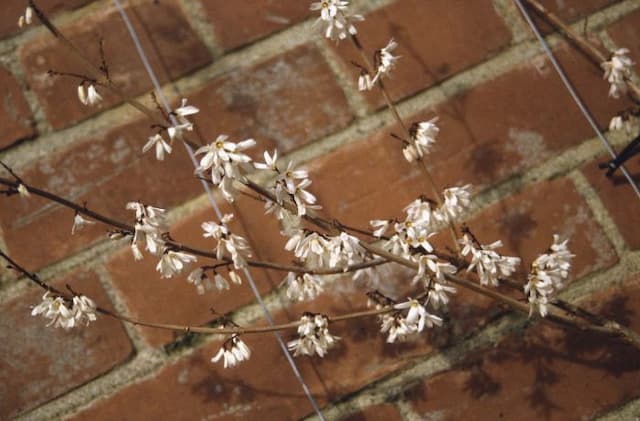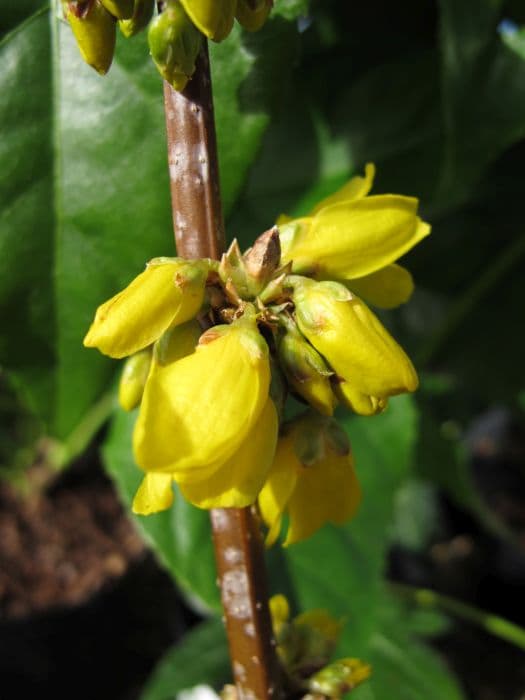Komarow's Lilac Syringa komarowii subsp. reflexa

ABOUT
The plant, commonly known as the reflexed lilac, is characterized by its striking floral and foliage features that make it a popular ornamental plant. It boasts heart-shaped leaves that are lush green in color, lending a full and vibrant backdrop for its blooms. The flowers themselves are the true standout, with panicles that cascade elegantly, comprised of small, fragrant blooms that can range in color, often presenting in delicate shades of pink or purple. These blossoms are notable for their alluring scent, which is strong and sweet, attracting pollinators and delighting the senses of passersby. The reflexed nature of its flower clusters gives the plant a distinctive look, as they curve outward and down, adding to the ornamental appeal. The stems and branches have a woody structure, providing a sturdy framework for the leaves and flowers, and contributing to an attractive growth habit that complements a variety of garden settings. Despite its captivating appearance, it's worth noting that the virtue of this plant lies not in its stature, but rather in the beauty of its blossoms and foliage.
About this plant
 Names
NamesFamily
Oleaceae
Synonyms
Koma Lilac, Reflexed Lilac
Common names
Syringa komarowii subsp. reflexa.
 Toxicity
ToxicityTo humans
The most common common name for Syringa komarowii subsp. reflexa is the reflexed lilac. Generally, lilacs are not considered to be highly toxic to humans. However, like many plants, they can cause some degree of discomfort if ingested, although serious poisoning is rare. Possible symptoms of ingesting parts of the reflexed lilac might include gastrointestinal upset, such as nausea, vomiting, and diarrhea. It's always advisable to avoid eating parts of ornamental plants due to the potential for mild toxicity or allergic reactions.
To pets
The most common common name for Syringa komarowii subsp. reflexa is the reflexed lilac. Lilacs are not commonly known to be poisonous to pets either. However, if a pet were to ingest a large amount of any part of the reflexed lilac, they might experience mild gastrointestinal upset, which could include symptoms such as vomiting and diarrhea. Usually, these symptoms are not severe, and the likelihood of serious poisoning is low. Nevertheless, it is best to prevent pets from eating ornamental plants to avoid any potential adverse reactions.
 Characteristics
CharacteristicsLife cycle
Perennials
Foliage type
Deciduous
Color of leaves
Green
Flower color
Pink
Height
6-8 feet (1.8-2.4 meters)
Spread
6-10 feet (1.8-3.0 meters)
Plant type
Shrub
Hardiness zones
5
Native area
China
Benefits
 General Benefits
General Benefits- Aesthetic Appeal: Adds visual interest to gardens with its cascading branches and reflexed, sweetly fragrant flowers.
- Habitat Support: Provides nectar to pollinators such as butterflies, bees, and hummingbirds, supporting local ecosystems.
- Shade Provision: Can offer a moderate amount of shade when planted in groups or as part of a hedge or shelterbelt.
- Privacy Screen: When planted in a row, it can create a natural and attractive privacy barrier between properties.
- Cultural Significance: Common lilac, including its subspecies, is often celebrated for its beauty and fragrance, featuring in festivals and gardens around the world.
- Low Maintenance: Generally requires minimal care once established, making it suitable for gardeners of all skill levels.
- Cold Hardiness: Capable of withstanding cold climates, making it a suitable choice for northern gardens.
- Erosion Control: Its root system can help stabilize soil on slopes and prevent erosion.
 Medical Properties
Medical PropertiesThis plant is not used for medical purposes.
 Air-purifying Qualities
Air-purifying QualitiesThis plant is not specifically known for air purifying qualities.
 Other Uses
Other Uses- Horticultural specimen: The Chinese lilac (Syringa komarowii subsp. reflexa) can be cultivated for its attractive, weeping branches, which provide an interesting shape in landscape design.
- Cut flowers: Its fragrant blooms are suitable for cut flower arrangements, bringing a pleasant scent and a touch of spring indoors.
- Botanical studies: Botanists and plant enthusiasts may use the species as a subject for research on plant growth habits and hybridization potential.
- Garden biodiversity: Chinese lilac can contribute to garden biodiversity by providing nectar and pollen for bees and other pollinators during its flowering period.
- Artistic inspiration: The weeping form and lush blooms of the Chinese lilac can serve as inspiration for artists and photographers.
- Educational tool: The plant can be used in educational settings such as schools and botanical gardens to teach about different types of flowering shrubs.
- Privacy screening: Taller specimens of Chinese lilac can be planted to create a privacy screen that also adds ornamental value to the landscape.
- Windbreak: In larger landscapes, rows of Chinese lilac could function as a windbreak, reducing soil erosion and protecting smaller plants.
- Cultural and ceremonial uses: Some cultures may incorporate Chinese lilac blooms in ceremonies or celebrations, particularly in the context of spring and fertility rites.
- Urban green spaces: Chinese lilac can be planted in parks and along city streets to green up urban environments and provide a splash of color.
Interesting Facts
 Feng Shui
Feng ShuiThe plant Syringa reflexa is not used in Feng Shui practice.
 Zodiac Sign Compitability
Zodiac Sign CompitabilityThe plant Syringa reflexa is not used in astrology practice.
 Plant Symbolism
Plant Symbolism- Love: As a variety of lilac, Syringa komarowii subsp. reflexa typically symbolizes love and affection, often reminding us of the emotions felt during an early romance.
- Innocence: The delicate blossoms of this plant are often associated with purity and the innocence of youth, which is a common theme across many types of lilacs.
- Renewal: Blooming in spring, this lilac variety is often seen as a symbol of renewal and the rebirth that comes with the season.
- Nostalgia: The scent of lilacs can evoke fond memories of the past, making this plant a symbol of nostalgia and the bittersweetness of reminiscing.
- Beauty: With its showy flowers, Syringa komarowii subsp. reflexa is often associated with natural beauty and elegance.
 Water
WaterThe Manchurian lilac (Syringa komarowii subsp. reflexa) prefers consistent moisture but does not tolerate waterlogged conditions. During its growing season, water the plant deeply once a week, applying about 1 gallon of water per square foot around its base. Adjust watering frequency to ensure the soil remains moist but not soggy, as overwatering can lead to root rot. During hot, dry periods, additional watering may be necessary. In the fall and winter, reduce watering to match the plant's decreased need for moisture.
 Light
LightManchurian lilac thrives in full sun to partial shade. The ideal spot for this plant would be an area receiving at least 6 hours of direct sunlight daily. However, it can also tolerate some afternoon shade during the hottest parts of the day, which helps to protect its blossoms from scorching.
 Temperature
TemperatureManchurian lilac is best suited to temperate climates and can generally tolerate temperatures as low as -30°F and as high as 95°F. The ideal temperature range for this lilac is between 60°F and 75°F. It's important to protect the plant from extreme heat waves or unexpected frost.
 Pruning
PruningPrune Manchurian lilac immediately after the spring blooming period to encourage healthy growth and flower development. Remove any dead or damaged branches, and thin out crowded areas to improve air circulation. Pruning every year or every other year helps maintain the plant's shape and vigor. The best time for pruning is immediately after the flowers have faded.
 Cleaning
CleaningAs needed
 Soil
SoilThe best soil mix for growing Lilac (Syringa komarowii subsp. reflexa) is well-draining with plenty of organic matter, such as a blend of loam, peat moss, and perlite or sand. The soil pH should be slightly alkaline, around 6.5 to 7.5. Regular incorporation of compost can help maintain the soil structure and fertility favorable for the Lilac's growth.
 Repotting
RepottingLilacs (Syringa komarowii subsp. reflexa) are typically grown outdoors and only occasionally need repotting if they are kept in containers. For potted specimens, repotting every 3 to 4 years can prevent root crowding and replenish nutrients in the soil, ensuring the Lilac remains healthy.
 Humidity & Misting
Humidity & MistingThe Lilac (Syringa komarowii subsp. reflexa) prefers moderate humidity levels, which coincide with outdoor conditions in most temperate climates. A range between 40% to 60% humidity is optimal for healthy growth, which typically doesn’t require special attention when the plant is grown outdoors.
 Suitable locations
Suitable locationsIndoor
Ensure bright light, good air circulation, and water when the topsoil is dry.
Outdoor
Plant in full sun with well-draining soil and water regularly.
Hardiness zone
4-7 USDA
 Life cycle
Life cycleSyringa komarowii subsp. reflexa, commonly known as the Komarov's Lilac, starts its life cycle as a seed which germinates in favorable conditions with ample sunlight and well-drained soil. Upon sprouting, the seedling grows into a young plant, developing a woody stem and simple leaves characteristic of lilacs. The plant enters a juvenile phase, during which it grows in size and strength, but does not yet flower. After a few years, it reaches maturity and begins to produce fragrant inflorescences, clusters of small, pink to purple flowers that bloom in late spring to early summer. Following pollination, often aided by bees and butterflies, the flowers develop into brown capsules that contain seeds, completing the reproductive cycle. Komarov's Lilac can continue this cycle for several decades, as it is a perennial shrub that enters a period of dormancy in winter before resuming growth in the spring.
 Propogation
PropogationPropogation time
Spring to summer
Propogation: The most popular method of propagation for the plant Syringa komarowii subsp. reflexa, commonly known as lilac, is through softwood cuttings. This process typically occurs in late spring to early summer, when new growth is still flexible but has begun to mature. A cutting of about 4 to 6 inches (10 to 15 centimeters) is taken from a healthy plant, ensuring that at least two sets of leaves are present. The bottom set of leaves is removed, and the cut end is dipped into rooting hormone to encourage root development. The cutting is then planted in a mixture of peat and perlite or sand, kept under high humidity, and in indirect light until roots have established, which usually takes a few weeks. Once rooted, the cuttings can be potted into individual containers and grown on until they are ready to be planted out into their permanent locations.









